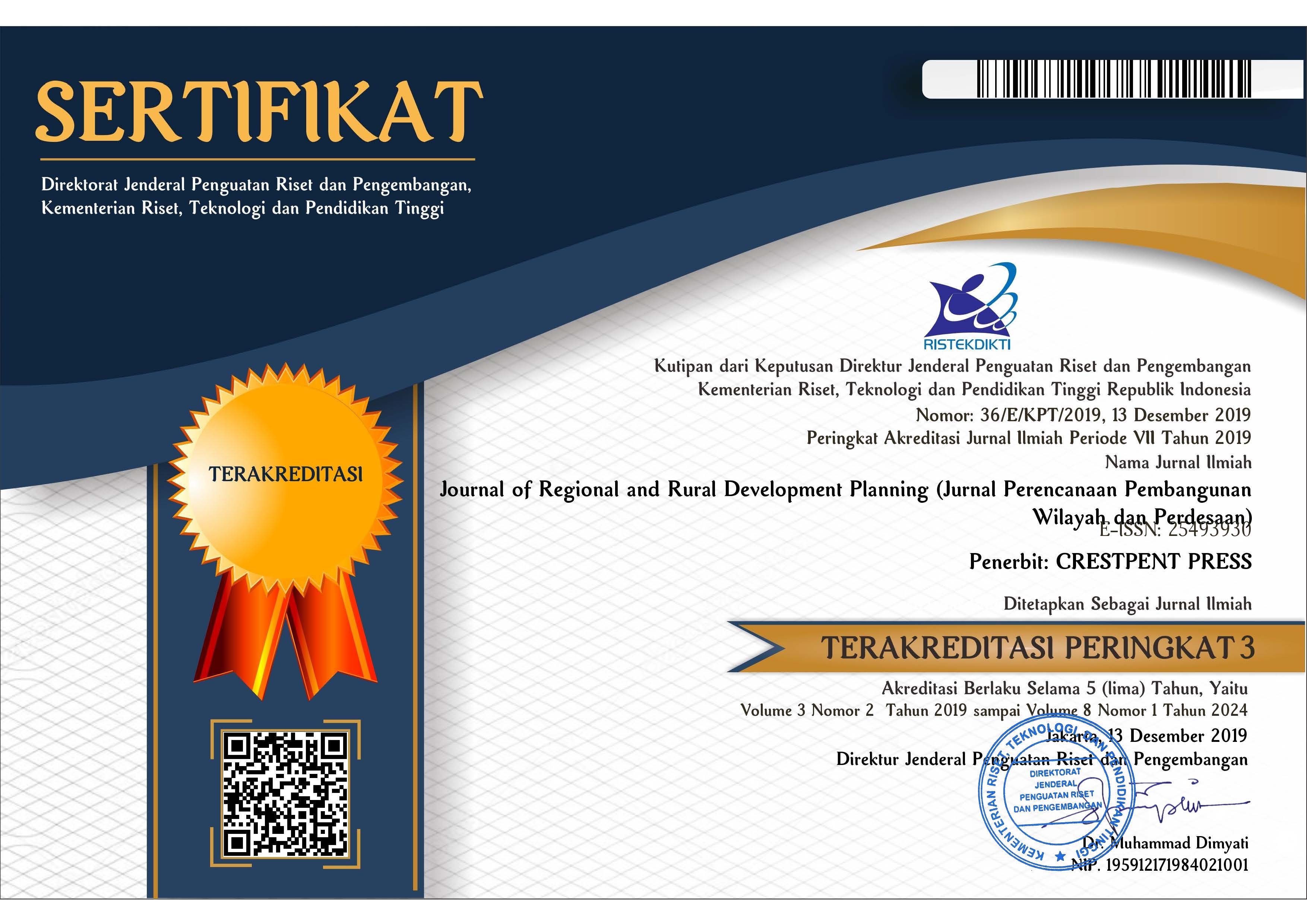Availability of Urban Infrastructure in Efforts to Establish Semarang Smart City in 2017
Abstract
Semarang city government has made efforts to digitize public services and provide Information and Communication Technology (ICT) infrastructure to establish Semarang as a smart city, but there are remaining problems. The objectives of this research are (1) to identify the availability of smart city infrastructure in Semarang; (2) to understand human resources that support the operation and utilization of infrastructure; (3) to provide direction for improvement and development of smart city infrastructure based on spatial approach. The variable of the research is the availability of urban ICT infrastructure, which consists of sub-variables of each infrastructure types. Analysis used in this research is secondary data analysis, together with district unit analysis using Guttman scale analysis, Scalogram analysis, and Centrality Index analysis. The result stated that there are no centrality of smart city infrastructure because the IS value is discovered 35.14 (medium), which is divided into 4 hierarchies of area services. The completeness level of facilities in each district ranged between medium (50-70%) and high (>75%). Therefore, the development of smart city infrastructure needs to be directed to southern and western regions that are in hierarchy service III and IV, balanced with the synergy between government and society in its implementation.
References
Firmansyah, R. A., Hariyanto, & Ariyani I. (2016). Dinamika Sistem Kota-Kota dan Pemilihan Alternatif Pusat Pertumbuhan Baru di Kota Semarang. Jurnal Geo Image 5 (2), 46-51.
Hardati, P. (2016). Hirarki Pusat Pelayanan Di Kecamatan Ungaran Barat dan Ungaran Timur Kabupaten Semarang. Jurnal Geografi, 13 (2) 205-224.
Hariyanto. (2014). Pengelolaan Sampah di Kota Semarang Untuk Menuju Kota Bersih. Jurnal Geografi, 11 (2), 237-246.
Hariyanto & Tukidi. (2007). Konsep Pengembangan Wilayah dan Penataan Ruang Indonesia di Era Otonomi Daerah. Jurnal Geografi, 4 (1), 1-10.
Hayati, R. (2013). Kajian Kerentanan Penghidupan Terhadap Fenomena Rob di Bagian Wilayah Kota (BWK) III Kota Semarang. Jurnal Geomedia, 11 (2), 171-181.
Indrayati, A. (2010). Studi Manajemen Infrastruktur Perkotaan Berbasis Komunitas Kasus: Manajemen MCK Komunal di Bantaran Sungai Kota Yogyakarta. Tesis. Yogyakarta: Universitas Gadjah Mada.
Indrayati, A. (2011). Pola Distribusi Keruangan MCK Komunal dan Hubungannya dengan Kawasan Kumuh di Perkotaan Yogyakarta. Jurnal Geografi, 8 (1), 54-63.
Muta’ali, L. (2003). Studi Penentuan Desa-Desa Pusat Pertumbuhan Di Propinsi Daerah Istimewa Yogyakarta. Majalah Geografi Indonesia, 17 (1), 33-51.
Muta’ali, L. (2015). Teknik Analisis Regional Untuk Perencanaan Wilayah, Tata Ruang dan Lingkungan. Yogyakarta: Badan Penerbit Fakultas Geografi Universitas Gadjah Mada.
Purnomo, F. Meyliana, & Harjanto P. (2015). Smart City Indicators: A Systematic Literature Review. Journal of Telecomunication, Electronic and Computer Engineering, 8 (3), 161-164.
Rangkuti, H. A., Erni S. & Rahma H. (2017). Analisis Pertumbuhan Urban Sprawl di Kecamatan Banyumanik Tahun 2005-2015. Jurnal Geo Image 6 (2),.82-88.
Riyanto, M. W., Moch. A., & Sriyono. (2014). Analisis Pengaruh Pertumbuhan Penduduk Terhadap Perkembangan Permukiman di Kecamatan Gajahmungkur Kota Semarang Tahun 2002-2012. Jurnal Geo Image 3 (2), 1-7.
Roche, S. (2014). Geographic Information Science I: Why does a smart city need to be spatially enabled? Progress in Human Geography Journal, 38 (5), 703-711.
Sariffuddin, S. (2015). Peluang Pengembangan Smart City Untuk Mewujudkan Kota Tangguh di Kota Semarang. Teknik, 36 (1), 32-38.
Setiawan, Didi., Z. S., & Ulfa M. (2016). Analisis Fungsi Pelayanan Kecamatan-Kecamatan di Bagian Timur Kabupaten Konawe Selatan. Jurnal Ekonomi, 1 (1), 44-55.
Siswanto, A., Saptono P, & Heri T. (2012). Kajian Tingkat Kemacetan Lalulintas Pada Jaringan Jalan Yang Menjadi Akses Masuk Kota Semarang. Jurnal Geo Image 1 (1). 82-88.
Supangkat, S. H., et al. (2015). Pengenalan dan Pengembangan Smart City. Bandung: e-Indonesia Initiatives Institut Teknologi Bandung.
Utari, M. G. Endang S. (2015). Analisis Sistem Pusat Pelayanan Permukiman di Kota Yogyakarta Tahun 2014. Journal of Economics and Policy, 8 (1), 62-72.
Copyright (c) 2018 Journal of Regional and Rural Development Planning

This work is licensed under a Creative Commons Attribution-ShareAlike 4.0 International License.




.png)














